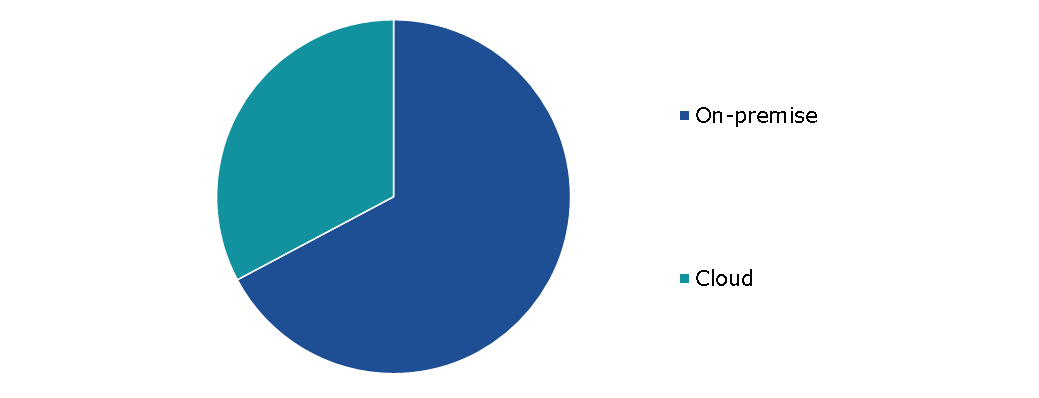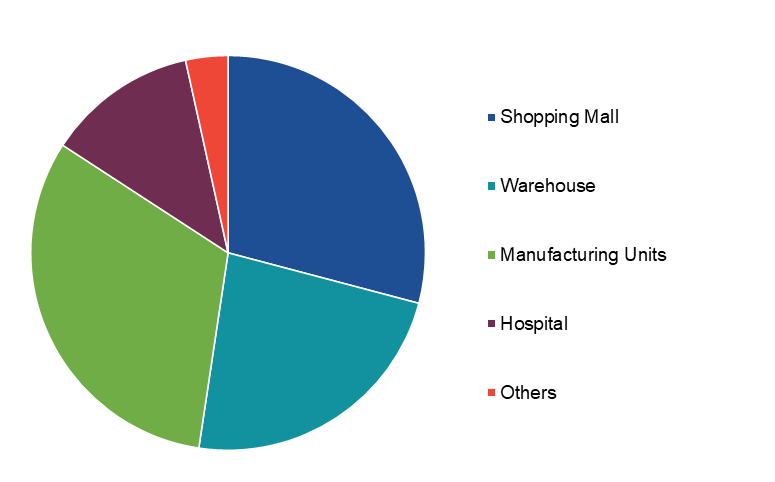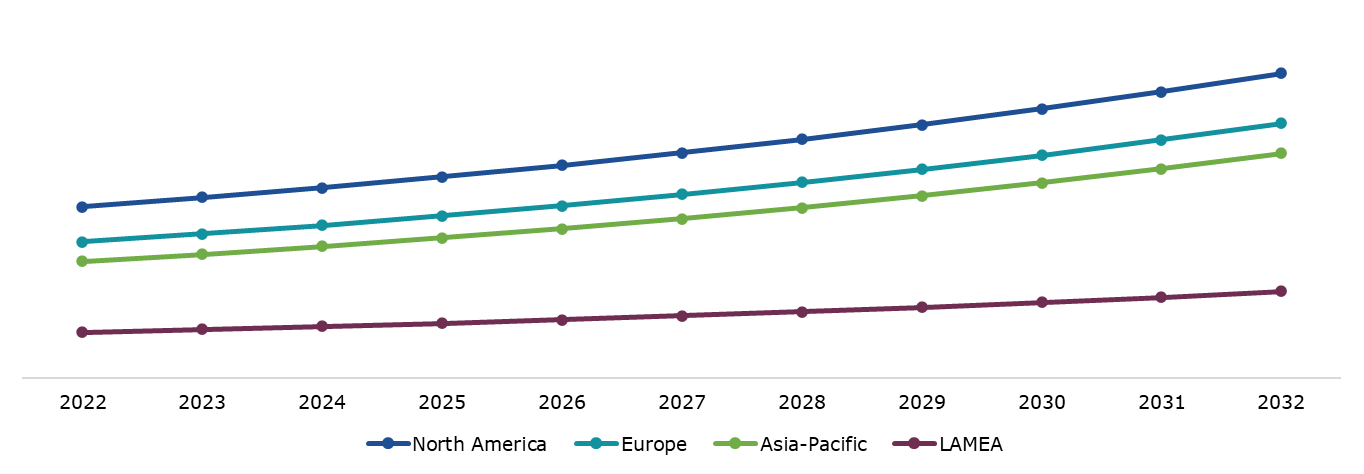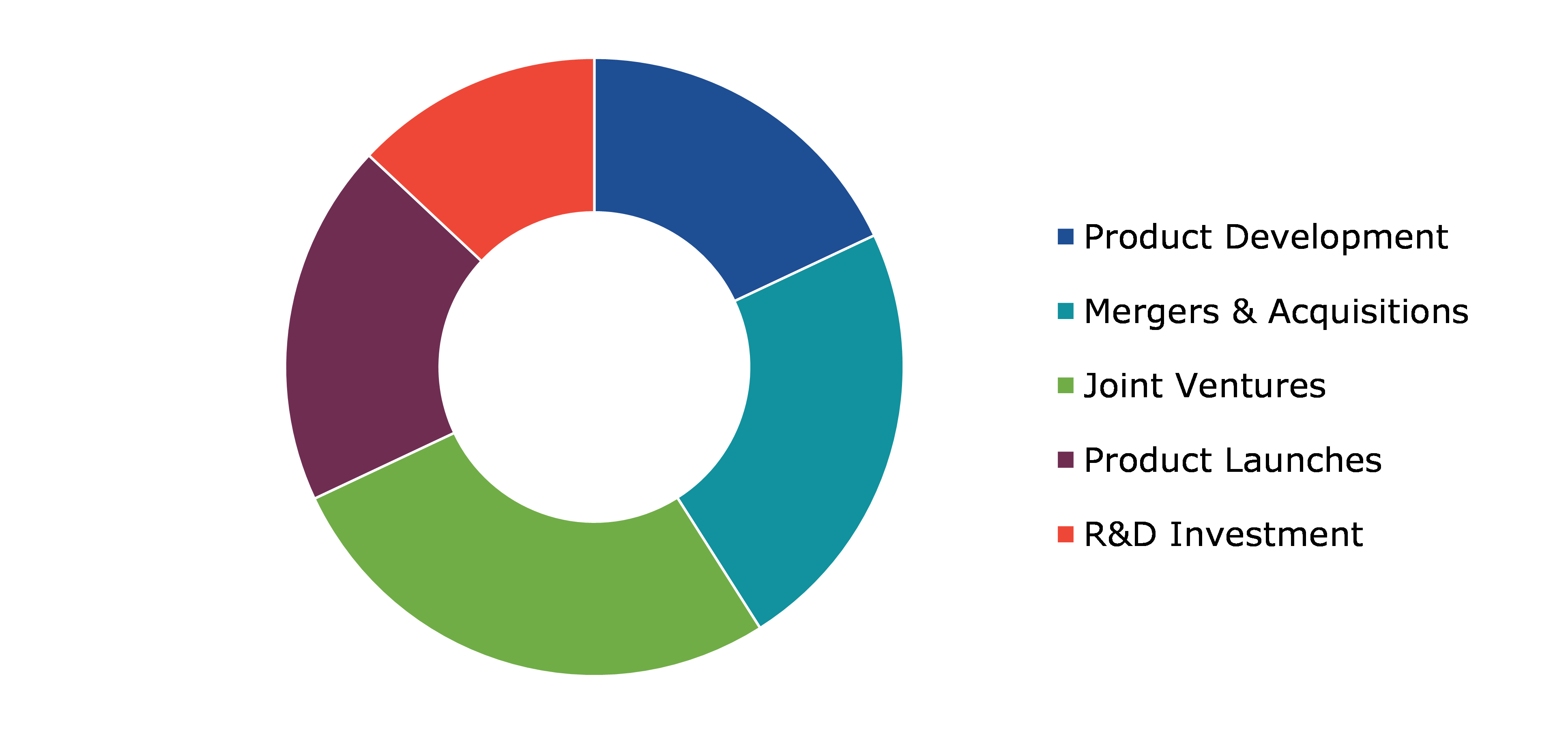Barcode Decoding Software Market Report
RA09199
Barcode Decoding Software Market by Deployment Mode (On-premise and Cloud), Application (Shopping Mall, Warehouse, Manufacturing Units, Hospital, and Others), and Region (North America, Europe, Asia-Pacific, and LAMEA): Global Opportunity Analysis and Industry Forecast, 2023-2032
Barcode Decoding Software Market Overview
Barcode decoding software is a tool used in various industries for quickly and accurately extracting information encoded in barcodes. These software applications employ advanced algorithms to interpret the patterns of bars and spaces within barcodes, translating them into meaningful data, which is easy to understand and is available to be utilized by businesses. The barcode decoding software functions by capturing an image of barcode using a compatible device such as a barcode scanner or a smartphone camera. Once the image is captured, the software analyzes barcode's structure, identifying different elements such as start & stop patterns, data modules, and any error correction codes present. The decoding process involves several steps, beginning with image preprocessing to enhance the quality of the captured barcode image. This includes tasks such as noise reduction, image rotation, and contrast adjustment to ensure optimal readability. Once the preprocessing is complete, the software employs various decoding algorithms tailored to the specific barcode symbology being used, such as UPC, Code 128, or QR codes.
Moreover, barcode decoding software plays a crucial role in streamlining operations, improving accuracy, and enhancing efficiency across a wide range of industries, from retail & logistics to healthcare & manufacturing. Its ability to quickly & accurately extract information from barcodes helps businesses automate processes, track inventory, authenticate products, and facilitate seamless transactions.
Global Barcode Decoding Software Market Analysis
The global barcode decoding software market was $329,800.0 thousand in 2022 and is predicted to grow with a CAGR of 6.4%, generating revenue of $612,101.8 thousand by 2032.
Source: Research Dive Analysis
COVID-19 Impact on Global Barcode Decoding Software Market
The COVID-19 pandemic had a significant impact on various sectors, including technology and software development. Barcode decoding software is used primarily in retail, logistics, and healthcare industries. The foremost impact of COVID-19 on barcode decoding software was increase in demand for contactless transactions and inventory management solutions. With social distancing measures and hygiene concerns, businesses accelerated the adoption of barcode technology to minimize physical contact as well as streamline operations. This surge in demand prompted barcode decoding software developers to enhance their products to meet the evolving needs of customers, such as improving scanning speed, accuracy, and compatibility with various barcode types. In addition, the pandemic led to disruptions in global supply chains, affecting the production and distribution of hardware components essential for barcode scanners & readers. Delays in manufacturing & shipping resulted in shortages and rise in costs for these devices, affecting the overall ecosystem of barcode decoding software. Software developers had to navigate these challenges by optimizing their algorithms to work efficiently with existing hardware or exploring alternative sourcing options to mitigate supply chain risks.
Escalating E-commerce Industry to Drive the Market Growth
The increasing e-commerce industry has observed growth in recent years, propelled by the widespread adoption of online shopping platforms and digital marketplaces. As consumers have experienced the convenience of shopping from their computers and smartphones, the demand for efficient & reliable barcode decoding software has surged. This software plays a major role in facilitating seamless transactions, inventory management, and supply chain operations within the e-commerce ecosystem. Barcode decoding is essential for e-commerce operations enabling retailers and logistics providers to accurately identify & track products throughout the entire distribution process. With the exponential rise in online shopping activities, businesses observed challenges in managing vast inventories and fulfilling orders with speed & precision. Barcode decoding software provides the necessary tools to streamline these processes, allowing companies to optimize their operational efficiency and meet the growing demands of online consumers. Moreover, as the e-commerce landscape continues to evolve, so do the complexities associated with product identification and authentication. Barcode decoding software equipped with advanced features such as image recognition and machine learning algorithms has become indispensable in deciphering a diverse array of barcode formats and symbologies. This versatility ensures compatibility with various product packaging designs and labeling standards, thereby enhancing the accuracy & reliability of inventory management systems.
Security and Data Privacy Concerns to Restrain the Market Growth
Barcode data is a critical component in various industries, facilitating efficient inventory management, product tracking, and transaction processing. However, with the convenience offered by barcode technology there are significant security and data privacy concerns associated. The sensitive nature of information encoded within barcodes, ranging from product details to & and transaction data, necessitates stringent measures to safeguard against unauthorized access and potential breaches. Industries such as healthcare and finance, where regulatory compliance is paramount, face high scrutiny regarding data security. In healthcare, barcodes are often used to track medical supplies, patient records, and pharmaceuticals, containing highly sensitive information such as patient identities & medical histories. Similarly, in finance, barcodes are utilized in payment processing, invoice management, and inventory tracking, holding confidential financial data & transaction records. Any breach or unauthorized access to this information leads to severe consequences, including regulatory penalties, financial losses, and reputational damage. Barcode decoding software providers are expected to prioritize the implementation of robust security measures to mitigate these risks effectively. This includes encryption techniques to protect data both at rest & in transit, access controls to restrict unauthorized users from viewing or modifying sensitive information, and regular security audits to identify & address potential vulnerabilities. In addition, compliance with industry-specific regulations such as health insurance portability and accountability act (HIPAA) in healthcare and payment card industry data security standard (PCI-DSS) in finance is essential to ensure adherence to legal requirements & standards for data protection. These factors hamper the market growth.
Surging Adoption of Barcode Decoding Software in Healthcare Sector to Drive Excellent Opportunities
The healthcare sector is experiencing a notable surge in the adoption of barcode decoding software, providing an opportunity within the industry. This upsurge is attributed to increase in recognition of the efficiency and accuracy that such software brings to various healthcare processes. By deploying barcode technology, healthcare facilities are enhancing their operational efficiency and patient care standards. At the forefront of this trend is the realization that barcode decoding software streamlines significant tasks such as medication management, inventory control, and patient identification. Using barcoded labels, healthcare professionals efficiently track medications from prescription to administration, reducing the risk of errors & ensuring patient safety. Moreover, barcode technology facilitates inventory management by enabling real-time tracking of medical supplies & equipment; thus, optimizing resource allocation and minimizing waste. Furthermore, barcode decoding software plays a pivotal role in enhancing patient identification processes, thereby reducing instances of medical errors and ensuring accurate treatment administration. By scanning patient wristbands or identification cards; healthcare providers access crucial medical information, verify patient identities, and match them with prescribed treatments or procedures; thereby enhancing overall patient safety & quality of care. The widespread adoption of barcode decoding software is driven by its compatibility with existing healthcare systems and interoperability with electronic health records (EHRs).
Global Barcode Decoding Software Market Share, by Deployment Mode, 2022
Source: Research Dive Analysis
The on-premise segment accounted for the highest market share in 2022. This indicates a prevalent preference among consumers for solutions installed and operated within their own physical infrastructure rather than relying on cloud-based alternatives. The prominence of on-premise solutions highlights the importance placed on data security, control, and concerns regarding internet connectivity reliability. By opting for on-premise barcode decoding software, businesses exercise greater control over their operations and data, ensuring compliance with security standards & regulations. This trend suggests that despite the growing popularity of cloud-based solutions, there remains a substantial demand for traditional on-premise software deployment models in the barcode decoding software market.
Global Barcode Decoding Software Market Share, by Application, 2022
Source: Research Dive Analysis
The manufacturing units segment accounted for the highest market share in 2022. This segment observed notable growth owing to surge in reliance on barcode decoding solutions within manufacturing facilities. The performance of this segment highlights its major role in enhancing efficiency, accuracy, and productivity within manufacturing operations. With barcode decoding software designed specifically for manufacturing units, businesses streamline their processes, optimize inventory management, and ensure seamless tracking and tracing of products throughout the production cycle. The software’s favorability in the market highlights its major role in delivering operational excellence and sustaining a competitive edge. Its widespread adoption signals the industry's acknowledgment of its inherent value. As industries continue to prioritize digitization and automation, the prominence of barcode decoding software within manufacturing units is poised to persist and evolve further in the future.
Barcode Decoding Software Market Size & Forecast, by Region, 2022-2032 ($Million)
Source: Research Dive Analysis
The North America barcode decoding software market generated the highest revenue in 2022. The region's performance highlights its significant role in advancing barcode technology and its applications. With a strong emphasis on technological innovation and a thriving business landscape, North America is established as a pivotal hub for barcode decoding software. This highlights the region's adaptability to evolving demands and its capacity to drive growth in the barcode industry. The success of North America in this sector emphasizes its competitive edge and its ability to capitalize on emerging opportunities in the market. As businesses substantially rely on efficient inventory management and streamlined operations, the demand for advanced barcode decoding software continues to grow, positioning North America at the forefront of this crucial technological frontier.
Competitive Scenario in the Global Barcode Decoding Software Market
Acquisition & mergers and market expansion are common strategies followed by major market players. For instance, on 28 November 2023, Honeywell unveiled its latest iteration of SwiftDecoder barcode-decoding software, designed to streamline shopping experience and enhance retail efficiency. With SwiftDecoder, camera-equipped devices seamlessly function as barcode scanners, ensuring swift and precise data capture. This advancement is particularly advantageous for retailers, as it incorporates augmented reality features into both customer-facing and store associate applications. By integrating these advanced reality plug-ins, productivity is significantly enhanced. Store associates effortlessly scan shelf tags and overlay pertinent graphics & information directly onto their screens, facilitating inventory management as welll as ensuring the accuracy of price labels. Furthermore, customers benefit from the integration by accessing promotional offers and nutritional information with ease, thereby contributing to a smooth checkout process. The integration of SwiftDecoder into retail operations promises to revolutionize the shopping experience, empowering both retailers and customers with innovative technology to navigate the complexities of modern retail environments.
Source: Research Dive Analysis
Some of the leading barcode decoding software market players are TEKLYNX, Capterra, Banner, Zebra, Loftware, Honeywell, Datalogic, Cognex vision, Archon Systems Inc., and Britecheck.
| Aspect | Particulars |
| Historical Market Estimations | 2020-2021 |
| Base Year for Market Estimation | 2022 |
| Forecast Timeline for Market Projection | 2023-2032 |
| Geographical Scope | North America, Europe, Asia-Pacific, and LAMEA |
| Segmentation by Deployment Mode |
|
| Segmentation by Application |
|
| Key Companies Profiled |
|
Q1. What is the size of the global barcode decoding software market?
A. The size of the global barcode decoding software market was $329,800.0 thousand in 2022 and is projected to reach $612,101.8 thousand by 2032.
Q2. Which are the major companies in the barcode decoding software market?
A. TEKLYNX, Capterra, Banner, Zebra, Loftware, Honeywell, Datalogic, Cognex vision, Archon Systems Inc., and Britecheck are some of the key players in the global barcode decoding software market.
Q3. Which region, among others, possesses greater investment opportunities in the future?
A. Asia-Pacific possesses great investment opportunities for investors in the future.
Q4. What is the expected growth rate of the Asia-Pacific barcode decoding software market?
A. The Asia-Pacific barcode decoding software market is anticipated to grow at 6.9% CAGR during the forecast period.
Q5. What are the strategies opted by the leading players in this market?
A. Acquisition & mergers and market expansion are the two key strategies opted by the operating companies in this market.
Q6. Which companies are investing more in R&D practices?
A. Honeywell and Cognex vision are the companies investing more in R&D activities for developing new products & technologies.
1. Research Methodology
1.1. Desk Research
1.2. Real time insights and validation
1.3. Forecast model
1.4. Assumptions and forecast parameters
1.5. Market size estimation
1.5.1. Top-down approach
1.5.2. Bottom-up approach
2. Report Scope
2.1. Market definition
2.2. Key objectives of the study
2.3. Market segmentation
3. Executive Summary
4. Market Overview
4.1. Introduction
4.2. Growth impact forces
4.2.1. Drivers
4.2.2. Restraints
4.2.3. Opportunities
4.3. Market value chain analysis
4.3.1. List of manufacturers
4.3.2. List of distributors
4.4. Innovation & sustainability matrices
4.4.1. Technology matrix
4.4.2. Regulatory matrix
4.5. Porter’s five forces analysis
4.5.1. Bargaining power of suppliers
4.5.2. Bargaining power of consumers
4.5.3. Threat of substitutes
4.5.4. Threat of new entrants
4.5.5. Competitive Rivalry Intensity
4.6. PESTLE analysis
4.6.1. Political
4.6.2. Economical
4.6.3. Social
4.6.4. Technological
4.6.5. Legal
4.6.6. Environmental
4.7. Impact of COVID-19 on barcode decoding software market
4.7.1. Pre-covid market scenario
4.7.2. Post-covid market scenario
5. Barcode Decoding Software Market Analysis, By Deployment Mode
5.1. Overview
5.2. On-premise
5.2.1. Definition, key trends, growth factors, and opportunities
5.2.2. Market size analysis, by region, 2022-2032
5.2.3. Market share analysis, by country, 2022-2032
5.3. Cloud
5.3.1. Definition, key trends, growth factors, and opportunities
5.3.2. Market size analysis, by region, 2022-2032
5.3.3. Market share analysis, by country, 2022-2032
5.4. Research Dive Exclusive Insights
5.4.1. Market attractiveness
5.4.2. Competition heatmap
6. Barcode Decoding Software Market Analysis, by Application
6.1. Overview
6.2. Shopping Mall
6.2.1. Definition, key trends, growth factors, and opportunities
6.2.2. Market size analysis, by region, 2022-2032
6.2.3. Market share analysis, by country, 2022-2032
6.3. Warehouse
6.3.1. Definition, key trends, growth factors, and opportunities
6.3.2. Market size analysis, by region, 2022-2032
6.3.3. Market share analysis, by country, 2022-2032
6.4. Manufacturing Units
6.4.1. Definition, key trends, growth factors, and opportunities
6.4.2. Market size analysis, by region, 2022-2032
6.4.3. Market share analysis, by country, 2022-2032
6.5. Hospital
6.5.1. Definition, key trends, growth factors, and opportunities
6.5.2. Market size analysis, by region, 2022-2032
6.5.3. Market share analysis, by country, 2022-2032
6.6. Others
6.6.1. Definition, key trends, growth factors, and opportunities
6.6.2. Market size analysis, by region, 2022-2032
6.6.3. Market share analysis, by country, 2022-2032
6.7. Research Dive Exclusive Insights
6.7.1. Market attractiveness
6.7.2. Competition heatmap
7. Barcode Decoding Software Market, by Region
7.1. North America
7.1.1. U.S.
7.1.1.1. Market size analysis, by Deployment Mode, 2022-2032
7.1.1.2. Market size analysis, by Application, 2022-2032
7.1.2. Canada
7.1.2.1. Market size analysis, by Deployment Mode, 2022-2032
7.1.2.2. Market size analysis, by Application, 2022-2032
7.1.3. Mexico
7.1.3.1. Market size analysis, by Deployment Mode, 2022-2032
7.1.3.2. Market size analysis, by Application, 2022-2032
7.1.4. Research Dive Exclusive Insights
7.1.4.1. Market attractiveness
7.1.4.2. Competition heatmap
7.2. Europe
7.2.1. Germany
7.2.1.1. Market size analysis, by Deployment Mode, 2022-2032
7.2.1.2. Market size analysis, by Application, 2022-2032
7.2.2. UK
7.2.2.1. Market size analysis, by Deployment Mode, 2022-2032
7.2.2.2. Market size analysis, by Application, 2022-2032
7.2.3. France
7.2.3.1. Market size analysis, by Deployment Mode, 2022-2032
7.2.3.2. Market size analysis, by Application, 2022-2032
7.2.4. Spain
7.2.4.1. Market size analysis, by Deployment Mode, 2022-2032
7.2.4.2. Market size analysis, by Application, 2022-2032
7.2.5. Italy
7.2.5.1. Market size analysis, by Deployment Mode, 2022-2032
7.2.5.2. Market size analysis, by Application, 2022-2032
7.2.6. Rest of Europe
7.2.6.1. Market size analysis, by Deployment Mode, 2022-2032
7.2.6.2. Market size analysis, by Application, 2022-2032
7.2.7. Research Dive Exclusive Insights
7.2.7.1. Market attractiveness
7.2.7.2. Competition heatmap
7.3. Asia-Pacific
7.3.1. China
7.3.1.1. Market size analysis, by Deployment Mode, 2022-2032
7.3.1.2. Market size analysis, by Application, 2022-2032
7.3.2. Japan
7.3.2.1. Market size analysis, by Deployment Mode, 2022-2032
7.3.2.2. Market size analysis, by Application, 2022-2032
7.3.3. India
7.3.3.1. Market size analysis, by Deployment Mode, 2022-2032
7.3.3.2. Market size analysis, by Application, 2022-2032
7.3.4. Australia
7.3.4.1. Market size analysis, by Deployment Mode, 2022-2032
7.3.4.2. Market size analysis, by Application, 2022-2032
7.3.5. Indonesia
7.3.5.1. Market size analysis, by Deployment Mode, 2022-2032
7.3.5.2. Market size analysis, by Application, 2022-2032
7.3.6. Rest of Asia-Pacific
7.3.6.1. Market size analysis, by Deployment Mode, 2022-2032
7.3.6.2. Market size analysis, by Application, 2022-2032
7.3.7. Research Dive Exclusive Insights
7.3.7.1. Market attractiveness
7.3.7.2. Competition heatmap
7.4. LAMEA
7.4.1. Brazil
7.4.1.1. Market size analysis, by Deployment Mode, 2022-2032
7.4.1.2. Market size analysis, by Application, 2022-2032
7.4.2. UAE
7.4.2.1. Market size analysis, by Deployment Mode, 2022-2032
7.4.2.2. Market size analysis, by Application, 2022-2032
7.4.3. South Africa
7.4.3.1. Market size analysis, by Deployment Mode, 2022-2032
7.4.3.2. Market size analysis, by Application, 2022-2032
7.4.4. Argentina
7.4.4.1. Market size analysis, by Deployment Mode, 2022-2032
7.4.4.2. Market size analysis, by Application, 2022-2032
7.4.5. Rest of LAMEA
7.4.5.1. Market size analysis, by Deployment Mode, 2022-2032
7.4.5.2. Market size analysis, by Application, 2022-2032
7.4.6. Research Dive Exclusive Insights
7.4.6.1. Market attractiveness
7.4.6.2. Competition heatmap
8. Competitive Landscape
8.1. Top winning strategies, 2022
8.1.1. By strategy
8.1.2. By year
8.2. Strategic overview
8.3. Market share analysis, 2022
9. Company Profiles
9.1. TEKLYNX
9.1.1. Overview
9.1.2. Business segments
9.1.3. Product portfolio
9.1.4. Financial performance
9.1.5. Recent developments
9.1.6. SWOT analysis
9.2. Capterra
9.2.1. Overview
9.2.2. Business segments
9.2.3. Product portfolio
9.2.4. Financial performance
9.2.5. Recent developments
9.2.6. SWOT analysis
9.3. Banner
9.3.1. Overview
9.3.2. Business segments
9.3.3. Product portfolio
9.3.4. Financial performance
9.3.5. Recent developments
9.3.6. SWOT analysis
9.4. Zebra
9.4.1. Overview
9.4.2. Business segments
9.4.3. Product portfolio
9.4.4. Financial performance
9.4.5. Recent developments
9.4.6. SWOT analysis
9.5. Loftware
9.5.1. Overview
9.5.2. Business segments
9.5.3. Product portfolio
9.5.4. Financial performance
9.5.5. Recent developments
9.5.6. SWOT analysis
9.6. Honeywell
9.6.1. Overview
9.6.2. Business segments
9.6.3. Product portfolio
9.6.4. Financial performance
9.6.5. Recent developments
9.6.6. SWOT analysis
9.7. Datalogic
9.7.1. Overview
9.7.2. Business segments
9.7.3. Product portfolio
9.7.4. Financial performance
9.7.5. Recent developments
9.7.6. SWOT analysis
9.8. Cognex vision
9.8.1. Overview
9.8.2. Business segments
9.8.3. Product portfolio
9.8.4. Financial performance
9.8.5. Recent developments
9.8.6. SWOT analysis
9.9. Archon Systems Inc.
9.9.1. Overview
9.9.2. Business segments
9.9.3. Product portfolio
9.9.4. Financial performance
9.9.5. Recent developments
9.9.6. SWOT analysis
9.10. Britecheck
9.10.1. Overview
9.10.2. Business segments
9.10.3. Product portfolio
9.10.4. Financial performance
9.10.5. Recent developments
9.10.6. SWOT analysis
Personalize this research
- Triangulate with your own data
- Request your format and definition
- Get a deeper dive on a specific application, geography, customer or competitor
- + 1-888-961-4454 Toll - Free
- support@researchdive.com






